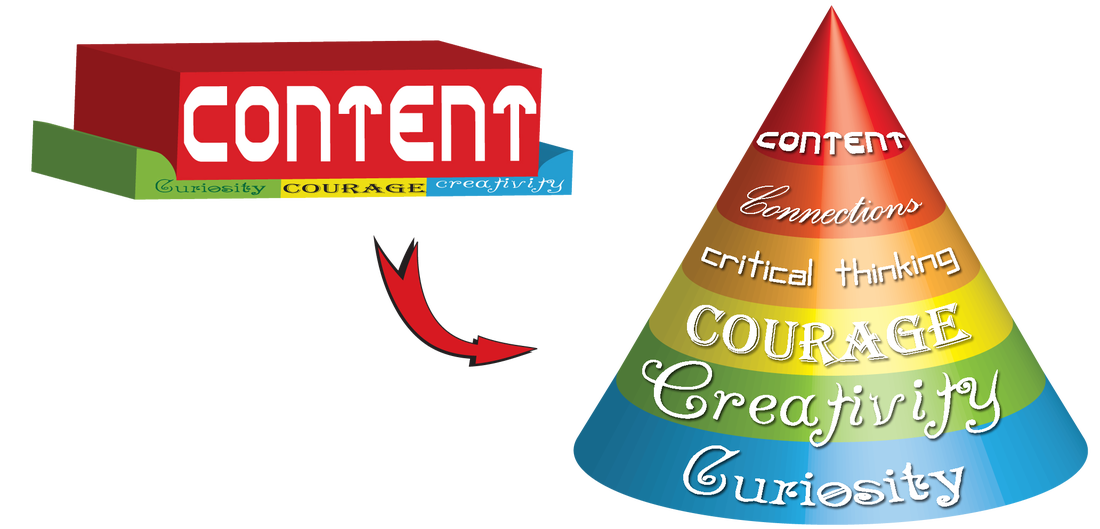I was thinking of a topic to bring to my blog, and kept coming back to 21st Century Skills. I think that's a big buzzword right now, and teachers are encouraged to focus on those more and more. We now know how important these skills are in the modern world, and still we realize how distant the majority of institutions are from embracing this change in focus. A slow revolution has started to brew, with a rising number of teachers and schools everywhere trying to figure out what is the best way to encourage these skills.
Traditional education was built around the idea of conformity; every child would get the same education, the same opportunities, display their learning the same way, and hopefully get out of the system with the same basic skills. But there are a couple of issues with this thinking.
One, people are not all the same. We learn differently, have different interests, backgrounds, strengths and weaknesses. Trying to fit everyone through the same mold ends up grinding all that is best and unique about every one of our learners until they start to question their essence, until they permanently conform or give up completely. Some still think, what is so bad about conforming to a specific mold, anyway?
This brings me to the second issue with traditional education: it is meant to control and oppress, to create perfect workers instead of independent thinkers. I could talk about this for hours -- maybe I'll go on and on in another blog!
By squashing critical thinking, students start to conform to an expectation that should no longer be the focus. The traditional system encourages fear of failure, less risk-taking, and a sense that the only way to succeed is to play by the rules. Successful students finish grade 12 with high marks, but without the ability to bounce back if life takes an unexpected turn. Globalism and technology had a profound impact on our society, and change is necessary in order to develop adaptable lifelong learners.
In short, a focus on content above all creates someone who is great at that content, but no longer an individual. All the important attributes they had as young children get squished away.
Traditional education was built around the idea of conformity; every child would get the same education, the same opportunities, display their learning the same way, and hopefully get out of the system with the same basic skills. But there are a couple of issues with this thinking.
One, people are not all the same. We learn differently, have different interests, backgrounds, strengths and weaknesses. Trying to fit everyone through the same mold ends up grinding all that is best and unique about every one of our learners until they start to question their essence, until they permanently conform or give up completely. Some still think, what is so bad about conforming to a specific mold, anyway?
This brings me to the second issue with traditional education: it is meant to control and oppress, to create perfect workers instead of independent thinkers. I could talk about this for hours -- maybe I'll go on and on in another blog!
By squashing critical thinking, students start to conform to an expectation that should no longer be the focus. The traditional system encourages fear of failure, less risk-taking, and a sense that the only way to succeed is to play by the rules. Successful students finish grade 12 with high marks, but without the ability to bounce back if life takes an unexpected turn. Globalism and technology had a profound impact on our society, and change is necessary in order to develop adaptable lifelong learners.
In short, a focus on content above all creates someone who is great at that content, but no longer an individual. All the important attributes they had as young children get squished away.
Will it really matter in 15 years if the child was able to memorize word by word a certain portion of a book? No. But it will matter if the child has learned to think for herself; to have confidence in her abilities to solve problems; to be a creative thinker, regardless of the scenario.
But if these skills are so important, how do we change things in our own classrooms? How to get from a heavy content to a point where 21st Century skills start to develop?
Turns out that creativity is something that can be encouraged and developed; children are born creative and willing to take risks. For us as educators to bring back that sense of wonder and creativity in our students, the best way is to encourage their curiosity. When content is given less of a focus, and curiosity is allowed space in the classroom, we end up seeing other skills appear.
But if these skills are so important, how do we change things in our own classrooms? How to get from a heavy content to a point where 21st Century skills start to develop?
Turns out that creativity is something that can be encouraged and developed; children are born creative and willing to take risks. For us as educators to bring back that sense of wonder and creativity in our students, the best way is to encourage their curiosity. When content is given less of a focus, and curiosity is allowed space in the classroom, we end up seeing other skills appear.
But how can we encourage something like curiosity? How can we encourage students to think about different possibilities instead of trying to please us and give us the "right" answer?
I've come up with some ideas that can encourage this to happen, and these are very useful for a face-to-face and blended models; some of the ideas can also be adapted to online learning.
1. Create a double-entry journal between you and the students, where you can start a dialogue with them regarding your subject. No judgment! Welcome and honour all ideas, even the negative ones. This will help you quickly build trust, which is necessary when encouraging curiosity and risk-taking.
2. Bring make-believe into classroom. A good way to bring the drier bits of your content to a better light is to include them in some sort of make-believe. For instance, I had success teaching mitosis and meiosis by moving all chairs out of the way and getting the students to become a part of the cell, with students lassoing other students to divide the DNA equally. Afterwards, still on the circle, they were encouraged to describe what had happened, and participation was very high.
3. No words (or very few words) on slideshows. On slideshows, I have usually pictures and one or two words to provide focus and spark conversation. The students are encouraged to describe what they see, and I often get them out of their chairs and around me. This brings me to...
4. Get them out of their seats, asking questions. The division between you as expert and the student as learner should not exist anymore; you are their coach in this road to learning, and as such, you should encourage the students to huddle together around you. Being closer to other students also takes the spotlight from them and gives them better confidence to venture and shout out ideas. Debates should always be done out of their seats.
5. Mix it up. Whenever possible, bring lessons where they can build, reenact, experience or create in an open-ended way, such as models, crafts, building sets, posters, plays, music, reenactments, etc. This can be done for every single subject out there.
6. Remember there is no right or wrong for creative activities. Every answer shouted is a good answer; if nothing else, it took courage to bring it up, and that should be encouraged. Find what is good about the answer and respond accordingly. "Well, yes, I like your thinking, rats could be marsupials, after all they look just like possums. Anyone else has a different idea?"
7. Finally, every day, try to bring an interesting question about your subject, and don't give any answers until the next day. I like bringing an experiment or a slide and asking students to explain what is going on, taking their best guess. The first couple of times, students were concerned about voicing their opinions, but after that, they realized how there was no judgment, and those last few minutes of class became a bubbly, crazy time where all of them participated with ideas and suppositions, building upon each others' thoughts and conceptions. This was a perfect example of controlled chaos, something we can talk about later in more detail. THIS is the most important way to foster curiosity -- open-ended questions force students to allow for multiple answers and to be creative. Knowing the answer won't be given today also keeps the conversation bubbling.
If you have more ideas, please comment below. I have used these successfully in my classroom when teaching Science, and I really think these can be used when teaching any subject!
Boy. I do talk a lot!
I've come up with some ideas that can encourage this to happen, and these are very useful for a face-to-face and blended models; some of the ideas can also be adapted to online learning.
1. Create a double-entry journal between you and the students, where you can start a dialogue with them regarding your subject. No judgment! Welcome and honour all ideas, even the negative ones. This will help you quickly build trust, which is necessary when encouraging curiosity and risk-taking.
2. Bring make-believe into classroom. A good way to bring the drier bits of your content to a better light is to include them in some sort of make-believe. For instance, I had success teaching mitosis and meiosis by moving all chairs out of the way and getting the students to become a part of the cell, with students lassoing other students to divide the DNA equally. Afterwards, still on the circle, they were encouraged to describe what had happened, and participation was very high.
3. No words (or very few words) on slideshows. On slideshows, I have usually pictures and one or two words to provide focus and spark conversation. The students are encouraged to describe what they see, and I often get them out of their chairs and around me. This brings me to...
4. Get them out of their seats, asking questions. The division between you as expert and the student as learner should not exist anymore; you are their coach in this road to learning, and as such, you should encourage the students to huddle together around you. Being closer to other students also takes the spotlight from them and gives them better confidence to venture and shout out ideas. Debates should always be done out of their seats.
5. Mix it up. Whenever possible, bring lessons where they can build, reenact, experience or create in an open-ended way, such as models, crafts, building sets, posters, plays, music, reenactments, etc. This can be done for every single subject out there.
6. Remember there is no right or wrong for creative activities. Every answer shouted is a good answer; if nothing else, it took courage to bring it up, and that should be encouraged. Find what is good about the answer and respond accordingly. "Well, yes, I like your thinking, rats could be marsupials, after all they look just like possums. Anyone else has a different idea?"
7. Finally, every day, try to bring an interesting question about your subject, and don't give any answers until the next day. I like bringing an experiment or a slide and asking students to explain what is going on, taking their best guess. The first couple of times, students were concerned about voicing their opinions, but after that, they realized how there was no judgment, and those last few minutes of class became a bubbly, crazy time where all of them participated with ideas and suppositions, building upon each others' thoughts and conceptions. This was a perfect example of controlled chaos, something we can talk about later in more detail. THIS is the most important way to foster curiosity -- open-ended questions force students to allow for multiple answers and to be creative. Knowing the answer won't be given today also keeps the conversation bubbling.
If you have more ideas, please comment below. I have used these successfully in my classroom when teaching Science, and I really think these can be used when teaching any subject!
Boy. I do talk a lot!


 RSS Feed
RSS Feed



